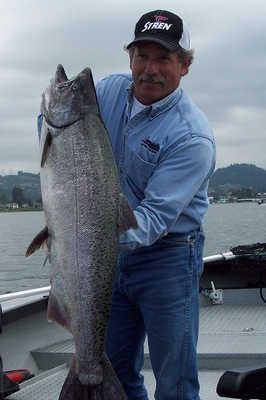forum
library
tutorial
contact

Tribes Take Issue with Hatchery Fish Study
by Phil RigdonThe Columbian, June 28, 2009
|
the film forum library tutorial contact |

|
Tribes Take Issue with Hatchery Fish Study
by Phil RigdonThe Columbian, June 28, 2009 |
Tribes take issue with hatchery fish study
 Tribal hatchery programs are restoring and rebuilding salmon runs throughout the Columbia Basin above Bonneville Dam, contrary to a recent study of summer steelhead that spawn in the West Fork of Hood River purporting to show damage to the fitness of wild runs.
Tribal hatchery programs are restoring and rebuilding salmon runs throughout the Columbia Basin above Bonneville Dam, contrary to a recent study of summer steelhead that spawn in the West Fork of Hood River purporting to show damage to the fitness of wild runs.
The Oregon State University study concluded that adult fish that are offspring of matings between hatchery-reared summer steelhead and wild summers have a lower reproductive rate than offspring of wild fish. The study implies the presence of a genetic "poison pill" that arises in hatchery-reared fish and is passed to succeeding generations, including those reproducing in the wild.
The Columbia River Treaty Tribes believe that careful scientific investigations always have a place in natural resources management, but we know from experience that some can mislead. In the OSU study, "The scientific data presented in this study are insufficient to reach broad conclusions regarding the reproductive success of hatchery-reared fish," said Dr. Shawn Narum, a geneticist at the Hagerman Fish Culture Experiment Station, a joint project of the University of Idaho and the Columbia River Inter-Tribal Fish Commission. In view of major implications such studies have for fishery policies, the region must be sure of its science before embarking on wholesale policy reform.
The Columbia River Treaty Tribes are gathering empirical evidence that hatchery-reared fish play an effective, if not essential, role in restoring salmon populations. Tribal programs in Oregon, Washington and Idaho utilize hatcheries with habitat improvements as the primary means of restoring wild salmon populations in tributaries throughout the Columbia Basin.
Supplementation of native populations with hatchery-reared salmon to increase natural spawning is a cornerstone to the tribes' efforts. In the Yakima River during the 1980s and 1990s, spring chinook numbered around 2,000 fish. After the Yakama Nation began its supplementation program, this run peaked in 2001 at 21,000 fish. Since then, more than 5,000 spring chinook return yearly as a result of the Yakama program.
Successes like this are repeated throughout the Columbia Basin. The Umatilla Tribes have been supplementing spring chinook in the Umatilla River. After a 70-year absence, the Umatilla River once again supports both sports and tribal fisheries. The Nez Perce Tribe succeeded in returning adult coho to the Clearwater River after these fish were extirpated by Snake River dams and overharvested below Bonneville Dam.
Precious resources
Where spring chinook were eliminated by the Powerdale Dam on the Hood River, the Warm Springs Tribes have reintroduced this prized salmon species and will perform the same study on their supplementation program as done by the OSU researchers to determine whether OSU conclusions hold true for other species and rearing methods.
The most successful supplementation program in the basin, begun in 1963 at Hanford Reach, provides fisheries from the Columbia along the Washington coast to Canada and Alaska.
Few things are more important to Native people than natural resources that have sustained them for countless generations. Few of these resources are more precious to the tribes than salmon that, in our belief, was the first to stand before the Creator and offer itself as food for Indian people. That is why our forefathers took care to ensure that our right to fish was secured in treaties with the United States, wherein we ceded large tracts of what are now the states of Washington, Oregon and Idaho in exchange for a promise by the United States to secure our rights to fish at all usual fishing places.
The Columbia River tribes have an abiding interest in using hatcheries to rebuild our salmon runs. In 1982, member tribes of the Columbia River Inter-Tribal Fish Commission first advocated hatcheries and habitat improvements, with reforms in hydro operations and harvest coordination to preserve and enhance wild salmon populations. Now these efforts are bearing fruit.
We do not wish to see these efforts derailed by premature conclusions from one study of one segment of one small population in one tributary of a tributary of the Columbia River. The tribes are carefully studying salmon programs that they implement, and we are committed to prudent stewardship.
Related Pages:
Hatchery Fish may Hurt Efforts to Sustain Wild Salmon Runs by Staff, Science Daily, 6/10/9
learn more on topics covered in the film
see the video
read the script
learn the songs
discussion forum
